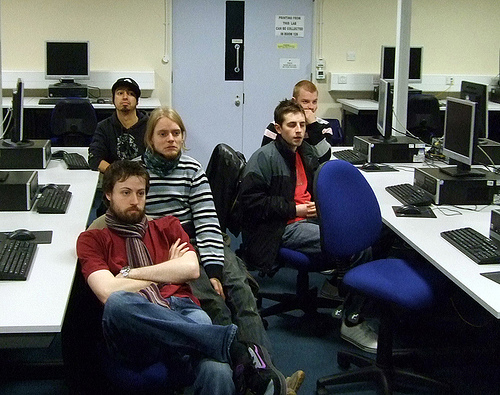I’ve been giving a bit of thought lately to digital identities and how those digital identities are shaped. And I stumbled on this paper written by Jenny Hughes and I (in trith more by Jenny than by me) and published in a book called ‘Vocational Education and training; culture, Values and Meanings’ edited by Eduardo Figueira. The book is probably long out of print – but I think soem of the ideas in the paper which basically explored borrowing tools from cultural science, to analyse education and training, warrant further exploration.. If you want to read more I have attached a word version of the full paper at the bottom of this post. Or if you just want an idea of what we are going on about here is an extract from the paper entitled ‘A possible cultural analysis of the functions of vocational education and training’.
1. To ARTICULATE the main lines of the established cultural consensus about the nature of the occupational sector(s) and the established sub-cultural consensus of the occupational sector about itself and its relation to the dominant culture.
For example, there will be a cultural consensus about “carpenters” based not necessarily on an external reality, but an intersubjective response based on the ‘myth’ of the carpenter. The myth will define such things as ‘who are carpenters’ (men, lower class), what carpenters do (work with wood), where they work (in the building industry) and a whole jumble of their values and beliefs and perceptions which could include ‘artisan’, ‘skilled’, ‘traditional’, ‘rustic’ and so on. Student carpenters as members of the culture will share these meanings.
Similarly, that subculture called ‘carpenters’ will also have a set of shared beliefs and meanings about itself which may be the same as, or different from, those of the dominant culture.
Carpenters will generate consensual understandings about defining themselves, for example, in terms of what they are not (not joiners, not cabinet makers). They will also share beliefs about what they need to know, do and understand to be a carpenter which is, to an extent, verifiable. On the other hand these shared beliefs may also extend to intangibles such as language codes, dress codes, defining relationships with other occupations.
So students of carpentry have to learn on the one hand the skills and knowledge needed to be a carpenter but they also have to learn what it means to be a carpenter.
VET, populated as it is by students and professionals who are simultaneously members of the dominant culture, members of a VET subculture and (usually) members of the ‘carpenters’ subculture is therefore a point of articulation in the sense of a joint and also a point of articulation in the sense of expressing or putting into words.
2. To IMPLICATE the individual members of the VET culture (whether teacher or student) into its dominant value system by exchanging status enhancing messages for the endorsement of that message’s ideology (as articulated in its mythology).
Participation in the VET process, for both teacher and learner, assumes a ‘joining –up’ or subscription process. This may be both conscious and unconscious. It may involve explicit initiation activities – for a student it may be filling out an enrolment form, for an apprentice it may be buying or being given a set of tools. The latter may become an almost ritualistic process with connotations which exceed the acquisition of the physical tools. Typically, new apprentices in the work place are often subjected to rituals which may be traditional and specific to that trade or workplace or more general, for example, being the butt of practical jokes. These rituals serve the same function as other rites of passage in that they convey a change of status and confer membership of the new culture.
By accepting membership, the apprentice or student ‘signs up’ to a new value system.
This concept of implication works in at least 2 ways:
The VET system, particularly at the stage of initial training, also serves the same function as an extended rite of passage. It changes the status of an individual from unskilled to skilled, untrained to trained, from not-a-carpenter to carpenter, from unqualified to qualified, from undergraduate to graduate and so on. Throughout the VET process cultural messages which reinforce the desirability of the changed (enhanced) status are constantly exchanged between those involved. The very act of participating in the VET process implicates those involved i.e. there is an outward sign that they subscribe to the validity of these messages (e.g. ‘Work hard’, ‘Do well’, ‘Pass exams’, ‘Get an A’).
ii) The VET system, as it relates to specific occupational areas, also transmits messages about the dominant value system in that occupational area. Using the same example, through the VET system, trainee carpenters will learn about the dominant value systems of the carpentry sub-culture (as explained above). However, it is not simply enough for them to learn this at an intellectual level but they need to learn at the level of lived experience. Occupational identity formation depends in large measure on the successful ‘implication’ function of VET.
3. To CELEBRATE, explain and interpret and justify the doings of the occupational cultures individual representatives in the world out there, using the mythology of individuality ‘to claw back’ individuals and the whole occupational subculture from eccentricity to a position of socio-centrality.
VET institutions and VET professionals often assume what is essentially a ‘public relations’ function on behalf of their particular sector. VET professionals involvement in conferences, seminars, open days, exhibitions and other similar events in which information about the social status, expertise and knowledge base of their sector is conveyed, performs this function at a surface level.
At a deeper level, the internal organisation of VET institutions into sectorally specific departments – or even monotechs – generates an organisational culture which reinforces sectoral identity and combats marginality. This has parallels in work-based VET as well as school based VET.
Take again the example of the ‘carpenter’ who, as an individual may also be brother, father, husband, citizen, sportsman and so on – identities which he shares with large numbers of others. The expectations, values and attitudes of the dominant culture with respect to these other roles are explicit and enjoy a high degree of intersubjectivity. In this context, to define oneself primarily as a ‘carpenter’ and see the world in general as a `carpenter` is eccentric. However, it is precisely this eccentric perspective which is legitimated, encouraged and reinforced within VET institutions.
Similarly , the VET professional who teaches ‘carpentry’ outside of his department, in the general VET culture or in the outside world is ‘a teacher’ or a ‘lecturer’. Within the building department or mono-tech institution, he reverts to being ‘a carpenter’.
It is also the function of VET to interpret and justify traditional practices and ‘ways of doing’ of the occupational sectors. Many of these practices may have (or have originally had) a logical basis but many are rooted in tradition and have become ritualised, contributing to the collective occupational identity of a particular sector.
That is students are not taught simply to be carpenters but are taught what it means to be a carpenter – how carpenters behave, how they think, how they see the world.
4. To ASSURE the occupational (and VET) subculture of its practical adequacy in the world by affirming and confirming its ideologies and mythologies in active engagement with the practical (and potentially unpredictable) dominant culture.
By this we mean the same ‘public relations’ function but within and between members of an occupational sub-culture rather than between that sub-culture and the ‘world-out- there’. This is the process of mutual reinforcement, of group identity, of self-congratulatory or self-justifying practices, codes of behaviour and shared meanings which are generated by the occupational sub culture about itself and which legitimate that sub-culture to itself.
VET is a key agent in reinforcing and sustaining this process.
5. To EXPOSE, conversely any practical inadequacies in the occupational and (VET) cultures sense of itself which might result from changed conditions in the world-out–there or pressure within the occupational (and VET) culture for a re-orientation in favour of a new ideological stance.
Most VET professionals would argue that a key task for VET practitioners is ensuring that their practices and curricula reflect the changing sectoral demands. However, the function of VET is not simply to respond in terms of content or methodology but, implicitly, it must reflect any change in the relationship between the occupational subculture and the dominant culture and represent any changes in the collective consciousness of the subculture.
Thus, VET can also be a key agent in changing the way an occupational sub-culture sees itself.
6. To CONVINCE the members of the occupational (and VET) culture that their status and identity as individuals is guaranteed by the culture as a whole.
Historically, this is probably the oldest and most important of VET functions and was central to the rationale of the Guilds and Craft Worker Federations. It was a key message transmitted through the traditional apprenticeship model and remains an issue for VET practice although arguably peripheral compared with those already discussed. Substitution of collectivism and the collective identity for individualism and a individual identity i.e. the Community of Practice becomes the source of meaning and occupational identity.
7. To TRANSMIT by these means a sense of cultural membership – membership of the dominant culture, the ‘world-out-there’ culture and their place within it the occupational culture or subcultures the VET culture itself.
This is a summative statement about the overall function of VET, synthesising the other six. A distinction is made between issues related to (e.g.) being a ‘carpenter’ (the occupational sub-culture) and issues related to being a member of the VET community of practice (trainee / student / learner / apprentice / teacher / lecturer). That is ‘learning what it means to be a trainee / student / learner / apprentice / teacher / lecturer is as important as learning what it means to be a carpenter.
You can download the full paper here: Culture paper



